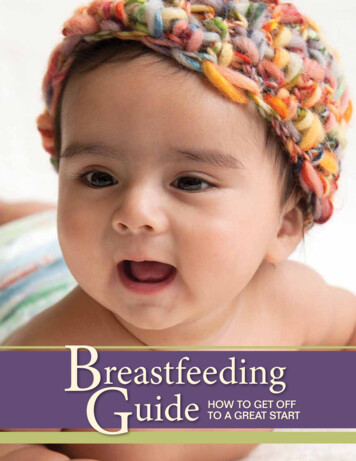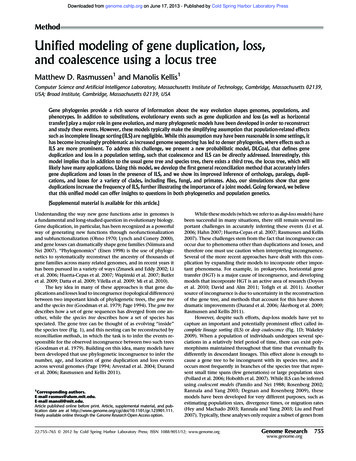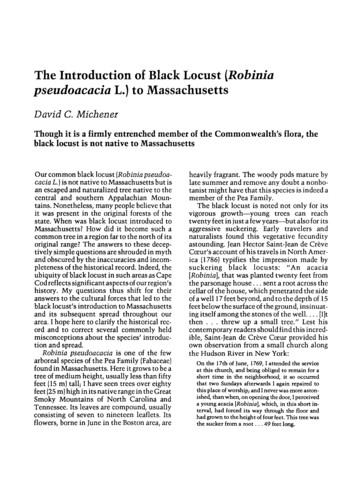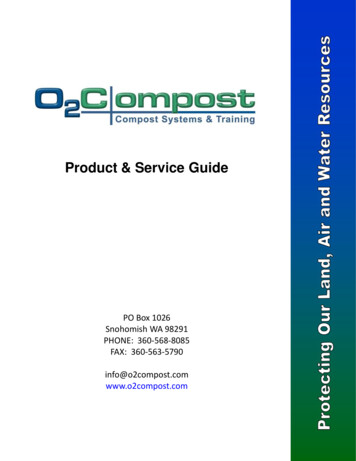
Transcription
BreastfeedinguideGHOW TO GET OFFTO A GREAT START
Breastfeeding Guide —How to Get Off to a Great StartEveryone needs good nutrition. But it is even moreimportant for babies and children because they needgood nutrition in order to grow and develop.Your breastmilk is more than nutrition. It also protectsyour baby. Your breastmilk helps keep your baby from gettingsick. And it lowers your baby’s risk of asthma, allergies, andsudden infant death syndrome (SIDS).Your breastmilk protects your child for a long time, long after youstop breastfeeding. For example, it lowers your baby’s risk of beingoverweight later in life. And it lowers his risk for adult diabetes andsome types of cancer.Breastfeeding is good for you, too. It lowers your risk of breast cancer, ovarian cancerand diabetes. And it burns about 600 calories a day, making it easier to lose some of the weightyou gained while you were pregnant. Breastfeeding also helps in other ways. It helps your baby’s braindevelop. It creates a close bond between you and your baby. It saves money in formula and health carecosts and cuts down on the days you miss from work. And breastmilk is a natural resource, so it helpsour planet.By breastfeeding, you are doing something that is good for your health and your baby’s health - for life.Congratulations for breastfeeding!
table of contentsBREASTFEEDING GUIDE — HOW TO GET OFF TO A GREAT START2DURING PREGNANCYYour body is built for breastfeedingHow long should I breastfeed?3FIRST HOURTips for getting breastfeeding off to a good startYour baby’s first hour4COLOSTRUMHand expression of colostrumOnce you are in your room5FEEDING POSITIONSHow do I hold my baby for breastfeeding?6 COMFORTABLE LATCHHow do I attach my baby to my breast?7 SIGNS OF HUNGER AND FULLHow often should I feed my baby?How do I tell if my baby is full?8WAKE YOUR BABYSleepy babies9 GAINING WEIGHTHow do I tell if my baby is getting enough to eat?10 REDUCING THE SWELLINGMy breasts feel too full. Do I have too much milk?Do I have too little milk?11TRACKINGFirst Week Daily Breastfeeding LogHow do I know if breastfeeding is going well?13TIPSHow do I know when to call the doctor?How do I take care of myself?
DURING PREGNANCYYour body isbuilt for breastfeedingDuring pregnancy, your body gets ready to breastfeed. In the fourth month of pregnancy, your breasts start makingcolostrum, the first milk for your baby. Colostrum can be yellow or clear. The colostrum that you feed your baby during thefirst few days after birth will boost his immune system and help him poop. This lowers his chance of jaundice, a conditionwhere the baby’s skin and eyes turn yellow.Your newborn baby has a tiny stomach – about the size of asmall marble. On the first day, his stomach can only hold aboutone teaspoon of colostrum each time you feed him. Your baby’sstomach and appetite will grow as he grows.Colostrum is the only thing your baby needs the first few daysafter he is born.Day 1Day 3Day 10How long shouldI breastfeed?Any amount of breastfeeding is good, butthe longer you breastfeed, the better. TheAmerican Academy of Pediatrics says thatwomen should breastfeed their babies“exclusively” (feed only breastmilk to theirbabies) for about the first 6 months. At thatpoint, mothers should start giving babyfoods and continue to breastfeed, at leastuntil the baby is 12 months old. Experts saythat women should keep breastfeeding afterone year as long as the mom and the babyboth want to.2BREASTFEEDING GUIDE
FIRST HOURTips for getting breastfeedingoff to a good startThese steps can help you breastfeed.Let your nurse know that you want tofollow these steps.1. Breastfeed within the first hour afterbirth, even if you had a caesarean(or c-section) birth.2. Feed only breastmilk to your baby.Ask for a breast pump if your baby is notfeeding from your breast.3. Hold your baby “skin-to-skin” as much asyou can. This means that your baby’s skin istouching your skin.4. Keep your baby in your room, day andnight, except for special procedures.5. Do not give a pacifier orbottle to your baby.Your baby’sfirst hourWhen your baby is born, he should be placedon your bare chest. This skin-to-skin contactwill comfort your baby after the delivery. The staffcan do most things they need to do while you areholding your baby. Your baby will start to look foryour breast and nipple. His head will bob up anddown as he crawls to your breast. It may take sometime, but your baby will attach to your breast whenhe is ready. It is truly amazing to watch your babyfind your breast and start feeding.If he does not show interest in the first hour, placehis cheek on top of one of your breasts so he can feel,smell and taste your nipple. If he still does not showinterest in eating, ask for help. Your baby shouldbreastfeed within the first hour or so after birth.BREASTFEEDING GUIDE3
DURING PREGNANCYHand expression of colostrumSome babies are extra sleepy in the first few days or need more time to practice breastfeeding. If your baby will not feed fromyour breast, you may need to remove your breastmilk by hand. This is called “hand expression.” Hand expression of colostrumis better than pumping because colostrum can stick to pump parts, so you might not collect as much of it.To hand express:1. Wash your hands.2. Use a clean container with a wide opening or a spoon to collect your colostrum.3. Hold the container near your nipple. With your other hand, place your fingers andthumb in line with your nipple and about one to two inches away from your nipple. Press your finger and thumb toward your ribs. Squeeze gently and catch your milk in the cup. Relax your hand. Repeat the process. Press in, squeeze gently, relax, and repeat.4. It may take a few minutes before you see any colostrum. Your baby onlyneeds about one teaspoon each time you feed him.5. Ask a nurse or lactation consultant to help you express and feedyour colostrum to your baby.Once you arein your room Ask to keep your baby in your room at all times – day and night. Feed only breastmilk to your baby. Do not give bottles or pacifiers. Hold your baby skin-to-skin as much as possible.Babies love skin-to-skin contact. Once you are in your room,dress your baby in just a diaper, cap, and socks and hold her against yourbare chest. Cover her back with a blanket. Tuck the ends of the blanketbehind your own back to keep her snuggled up close to you. You can alsoput a blanket around your shoulders, too. Skin-to-skin contact with dadis also a great way for dads to bond with their babies.Holding babies skin-to-skin helps them: Breastfeed better Cry less Recover from the delivery more quickly4BREASTFEEDING GUIDE
FEEDING POSITIONSHow do I holdmy baby for breastfeeding?There are many positions you can use. Try different positions to find what works best for you.Laid Back Hold Lay back and use pillows for support and comfort. Place your baby face down between your breasts. Let your baby search, crawl up, nuzzle, and attach to your breast.Help your baby in whatever way feels natural. Place a blanket across your baby’s back, if needed.Cross-Cradle Hold Place a pillow in your lap to bring your baby up to breast level.Put your baby on the pillow, tummy to tummy with you, with thebaby’s nose across from your nipple. Support your baby’s head by holding your hand at the base of his skull. Lift your breast to bring your nipple up to your baby’s nose. To lift yourbreast, lean back and place your fingers below your breast near yourribs, keeping your hand far away from the nipple. Once your baby is latched on, you can let go of your breast and bringyour arm around your baby into a regular cradle-hold. If your breastsare large, you may need to support your breast the whole time.Clutch (Football) Hold Place a pillow at your side. Put your baby on the pillow with his legs under your arm. Slide your arm under your baby’s back. Support the base of his headand neck with your hand.Side-Lying Hold Lie on your side with knees bent. Place pillows between your knees,under your head and neck, and behind your back, if needed. Put your baby on his side, facing your nipple. Support your baby by placing your arm, a pillow, or a rolled-up blanketbehind him.BREASTFEEDING GUIDE5
COMFORTABLE LATCHHow do I attachmy baby to my breast?If you are using the laid back position, allow your baby to latch on whenhe is ready. If you are using a different position, you will control theattachment more than your baby.Follow these tips1Hold your baby so that his nose is in linewith your nipple. Touch your baby’s noseand upper lip with your nipple.2Wait until his mouth opens very wide.3Quickly bring the baby onto your nippleand breast so that his chin touches yourbreast first and he gets a large mouthful ofnipple and breast.4If you feel painful tugging or pinching,slide your finger into the corner of hismouth to break the suction and try again.It may take a few tries to get a good,comfortable latch.You can tell your baby is attached well if: You are not feeling sharp pain. Gentle tugging is normal. Both of your baby’s lips are flipped out, not pulled in. More of the bottom of your areola (the dark area around nipple) isin the baby’s mouth than the top. His chin is buried in your breast with his nose tipped away slightlyor lightly touching. His mouth is as wide open as a yawn.After the first two days, you may also: Hear your baby swallow; or See milk leaking from your baby’s mouth or your other breast.Your nipple should look the same coming out of your baby’s mouthas it did going in. If your nipple looks pinched when it first comes outof your baby’s mouth, your baby is not attaching well. About half of allbabies don’t attach well on the first day. Ask for help right away and bepatient. It may take a few days for you and your baby to learn the artof breastfeeding.6BREASTFEEDING GUIDE
SIGNS OF HUNGER AND FULLNESSHow often shouldI feed my baby?Your baby is ready to feed any time heshows early signs of hunger, which are: Eye movements under eyelids Sucking motions while sleeping Restless body movements while sleeping Bringing hands toward mouthDon’t wait until he is fussy or crying. That makes itharder to breastfeed.If someone offers to take your baby to the nursery soyou can rest, tell them you would like to keep your babyin your room. Room-sharing protects you and your babyfrom infection, and helps you both sleep better. Also,you will get more skin-to-skin contact with your baby,and you will learn your baby’s hunger cues faster.How do I tell ifmy baby is full?Your baby will signal when he isfull when he: Lets go of your breast and nipple. Falls asleep and stops sucking. Relaxes his hands and body.If your baby comes off the breast relaxed andsleepy he has probably had a good feeding. If hestops sucking and does not come off the breast onhis own, slide your finger into the corner of hismouth to break the suction. Burp him and offerthe other breast. He may nurse again right awayor he may take the other side in a few minutesor a few hours.If your baby comes off the breast crying, hemay not be getting a good latch. Ask for helpright away.BREASTFEEDING GUIDE7
WAKE YOUR BABYSleepy babiesSleepy babies are not good at showing signs that they are hungry.Try waking your baby first with a variety of motions and sounds, such as different positions, using different words and sounds,and touching different parts of his body. Then get ready to feed. Place your baby in skin-to-skin contact and gently rub his back, arms, hands, and feet. Talk to him in a calming voice. When he begins to move more or opens his eyes, move him to your breast to feed. When he stops sucking, gently squeeze and massage your breast. Move your hand to a different area of your breast tomassage and squeeze every time your baby stops sucking.Most sleepy babies will get better at showing hunger cues in a few days. It may take 10 to 15 minutes to wake a sleepy baby.Sleepy babies should: be encouraged to nurse at least 8 times a day or every 1–3 hours during the day, and have no more than one four-hour sleep period in 24 hours.8BREASTFEEDING GUIDE
GAINING WEIGHTHow do I tell if my babyis getting enough to eat?Weight gain is the best way to tell if your baby is getting enough to eat. Tracking how many wet and poopy diapers your babyhas can also be helpful.Your baby may have some pale yellow, pink or red wet diapers and some black, brown or greenish poopy diapers in the firsttwo to three days.Baby’s Average Diaper Output in the First 4 WeeksDayWet DiapersUrine ColorPoopy DiapersPoop Color1Number will varyYellow/Pink/RedNumber will varyBlack2Number will varyYellow/Pink/RedNumber will varyBlackish/Green33 or moreYellow/Pink/Red3 or moreGreenish/Yellow44 or moreClear/Pale Yellow3 or moreGreenish/Yellow, Seedy5 to 286 or moreClear/Pale Yellow3 or moreYellow, SeedyYour baby’s poop can look watery and seedy and at other times it will look more like cottage cheese. By day six, many breastfedbabies will poop in almost every diaper. At least three or four of those diapers should have a large amount of poop - about thesize of a golf ball, but soft and spread out. After 4-6 weeks, a baby may only poop a few times a week.Day 1Day 3-4Day 5Newborns often lose weight in the first couple days of life. Your baby should regain his birth weight by day 10-14. After heregains his birth weight, he should gain about 4 to 8 ounces a week. Be sure to see your baby’s health care provider within3-5 days of hospital discharge to make sure your baby is gaining weight. Use the First Week Daily Breastfeeding Log on page11 of this book to track your baby’s diapers. When your baby is four days old, complete the How do I know if breastfeeding isgoing well survey, on page 12.BREASTFEEDING GUIDE9
REDUCING THE SWELLINGMy breasts feel too full.Do I have too much milk?When your baby is 2 to 5 days old, your milk supply will increase andyour breasts will feel heavier. Nurse your baby often to keep your breastsfrom becoming too full.If your breasts get too full, take a short, warm shower or put a warm, wettowel over your breasts and nipples for a minute or two and hand expressa little milk before each feeding. Gently massage your breasts toward yournipples while your baby is breastfeeding. Cold packs can be used for up to20 minutes between feedings if the fullness becomes uncomfortable.If your breasts become so full that you have troublehand expressing, try the softening method found vities.html.Do I havetoo little milk?Many babies will nurse very often at one time of the day.Many babies do this in the evening. This is normal. Themore often you nurse your baby, the more milk you willmake. Breastfeed often and do not give your baby formula.Exclusive breastfeeding for the first few weeks is veryimportant for building a good milk supply.Sometime between your baby’s first and third week of life,he may want to nurse more often. About this same timeyour breasts will naturally soften and feel less full. Thisdoes not mean you don’t have enough milk. It means yourbaby is having his first growth spurt and your milk supplyis changing to meet your baby’s needs.Try not to give your baby formula. Instead, set up a littlearea or “nest” by gathering plenty of supplies around yousuch as snacks, drinks, phone, remote controls, books, andmagazines. Try to spend as much time as you can in your“nest” with your baby so you can get to know and enjoyyour baby. Relax and nurse as often as your baby wants.Growth spurts usually happen around these times. 1 to 3 weeks of age 6 weeks of age 3 months of age10BREASTFEEDING GUIDE
First Week Daily Breastfeeding LogBaby’s Name:your baby was born and should be the same for each day.BBBBBBB 8-12 Goal6 Goal Fill in the start time and day of week in each box. The start time should be the timefor wet and soiled diapers.BB The day of week should change each day. Circle a B each time your baby breastfeeds. Circle a W each time your baby has a wet diaper. Circle an S each time your baby has a soiled or dirty diaper. Circle the plus sign if your baby has more than the daily goalBDay of Week:Day 1 (1st 24 hours)Start Time:BBBBBreastfeedingsBAnyB(pale yellow/pink/red)BWet diapersBAnyB(black tarry)BSoiled diapersDay of Week:Day 2 (2nd 24 hours)Start Time:BBAnyBBreastfeedings(pale yellow/pink/red)AnyBWet diapers(black tarry)8-12 GoalSoiled diapersDay of Week:Day 3 (3rd 24 hours)Start Time: B3-5 BB(pale yellow/pink/red)3-5 BB (greenish)BB BB BBreastfeedings BWet diapers BSoiled diapersThis institution is an equal-opportunity provider. 2011 Department of State Health Services. Nutrition Services Section.All rights reserved. Stock no. F13-06-13104 11/11Baby’s Birth Date:Birth Time:Day of Week:Day 4 (4th 24 hours)Start Time:Birthweight:GoalB3-5 8-12 B(clear/pale yellow)3-4 B (greenish to yellow)BB BB BB BBreastfeedings BWet diapers BSoiled diapersDay 5 (5th 24 hours)GoalB4-6 Day of Week:B(clear/pale yellow)Start Time:B 3-4 8-12 B (yellow, seedy) B BB BB BBreastfeedings BWet diapers BSoiled diapersDay 6-28B(clear/pale yellow)B4-6 GoalB Day of Week:B 3-4 Start Time:B (yellow, seedy)8-12 B B BB BBreastfeedings BWet diapers BSoiled diapersLet your baby breastfeed until he ends the feeding. Burp him and offer the other sideeach time. He may fill up on one breast but you should always offer the other to be sure. YouCAN’T nurse too often. You CAN nurse too little.A breastfed baby’s poop is normally loose and unformed and will change colors in thefirst several days. It should be yellow by day four. It may appear seedy to cottage cheesy.Your baby is probably getting enough to eat in his first week if he is meeting the goalsfor the number of daily breastfeedings and wet and dirty diapers and regains his birth weightby day 10-14. Some babies will go for days without a poop and this is normal too.If you have question about how to use this log, please call your WIC breastfeeding counselor.If your baby is not meeting the goals, call your doctor and your WIC breastfeeding counselor.Take this log to your baby’s doctor at his first office visit which should be at 3-5 days of age.
How do I know if breastfeeding is going well?The following questions will help you know whether you and your baby are off to a good startwith breastfeeding.Answer these questions when your baby is 4 days old.Do you feel breastfeeding is going well? Yes NoAre your baby’s swallows easier to hear since his first days in the hospital? Yes NoIs your baby able to latch on to your breasts without causing you discomfort? Yes NoDoes your baby let you know when he/she is hungry? Yes NoIs your baby alert and active? (Answer no if you have to wake your baby for mostfeedings.) Yes NoDoes your baby end each feeding by coming off your breast on his own? Yes NoDoes your baby seem calm and satisfied after feedings? Yes NoDo your breasts feel full before feedings? Yes NoDo you have any sore, tender areas in your breast that are firm and red? No YesDoes your baby nurse at least 8-12 times a day? Yes NoIs your baby waking at least one time during the night to breastfeed? Yes NoAre your nipples sore or do they look pinched when your baby comes offyour breast? No YesIs your baby having bowel movements that are soft and mustard-yellow? Yes NoIs your baby having 3 or more poopy diapers each day that are largersize of a quarter?than the Yes NoWhen you notice a wet diaper, is it clear to pale yellow? (Pink to red wetafter day four can be a sign of dehydration.)diapers Yes No Yes NoIs your baby having at least 3-5 wet diapers in 24 hours?If you only checked answers in the left column, you are doing well!If you checked any answers in the right column, call your WIC breastfeeding counselor right away.Call your WIC breastfeeding counselor any time you have anyquestions or concerns about breastfeeding.Adapted from The Breastfeeding Resource Center, Mercy Health Center, Oklahoma City, OK and The Lactation Program, Presbyterian/St. Luke’s Medical Center, Denver, CO
Breast Pumping When your milk is in, pump until milk stops coming out.Some women use a breast pump to express breast milk ifthey want to collect milk when they return to work, have apremature baby, or have feeding difficulties. A manual orelectric breast pump can be used. Ask for help in setting the pump up. Wash your hands. Put the breast cup over your areola with your nipple pointinginto the hole in the center of the cup. Hold the cup firmly against your breast to create a tight seal. Start with the pump at the lowest setting. Pumping shouldnot hurt. Pump each breast 10 to 15 minutes at first. Pump parts should be washed with hot, soapy water, or inthe top rack of the dishwasher.Storage and Use of Breast MilkStore your breast milk in clean containers. Use small containers so that you don’t have to defrost large amounts at a time. Label each container with the date it was pumped. Make sure the container is sealed well to prevent frost burnif freezing. Warm the milk in a container of warm water, don’t use themicrowave or stovetop. See below for breast milk storage guidelines for full-term babies.Breast Milk Storage Guidelines for Full-term BabiesRoomTemperatureRefrigeratorFresh breast milk6 to 8 hours5 to 7 days(just expressed)Previously frozenUse straight away,24 hoursbreast milk (thawed)do not storeTIPSHow do I knowwhen to call thedoctor?Home FreezerDeep Freezer3 months (don’tstore in the door)Never re-freeze6 to 12 monthsNever re-freezeYou should call your baby’sdoctor if he: Does not regain his birth weight by 2 weeks of age. Has fewer than six wet diapers a day by day six. Has fewer than three poops a day by day three. Still has black poop on day four. Will not wake up to nurse at least eight times a day. Falls asleep or stops nursing right after attaching toyour breast.How do I take care of myself?Forget about housework and try to sleep when your baby sleeps. When you are tired, lie down for feedings. Have snacksand drinks beside you each time you sit down to nurse. Keep meals simple – like a sandwich, soup, and fruit. Limit drinkswith caffeine to no more than three a day. Most medicines are safe to take when you are breastfeeding but check with yourdoctor to make sure. Or call the Infant Risk Center at 1-806-352-2519.Many women have mildly sore nipples the first few days of breastfeeding. If the discomfort only happens at thebeginning of feedings and goes away when your milk starts to flow or within 30 seconds, this is probably normal.To soothe sore nipples, rub breastmilk into them or use a lanolin cream that is made for breastfeeding mothers.If the soreness lasts the entire feeding or is severe, see a breastfeeding counselor right away. If you have soreness at thebeginning of feeding only and it does not go away within two weeks, see a breastfeeding counselor. Call your local WICclinic for breastfeeding help. Most likely, you are sore because of the way the baby is positioned or the way the baby islatching on. The soreness should go away after someone helps you figure out the cause.Hang in there. Breastfeeding gets easier. Take it one day at a time and be proud of what you are doing for your baby.You are giving your baby the best possible start in life.BREASTFEEDING GUIDE13
DURING PREGNANCYBREASTFEEDING HELP AND INFORMATIONWould you like to talk to someone about breastfeeding?Most WIC clinics have breastfeeding Peer Counselors who can help with basic breastfeedingissues and International Board Certified Lactation Consultants to help with more difficult problems.Peer Counselors are WIC moms just like you who have breastfed their own children. WIC trains themto help other moms. Call your WIC clinic to speak to a breastfeeding Peer Counselor.This institution is an equal-opportunity provider. 2012 Texas Department of State Health Services. Nutrition Services Section. All rights reserved.Stock no. 13-220 rev. 11/12
Squeeze gently and catch your milk in the cup. Relax your hand. Repeat the process. Press in, squeeze gently, relax, and repeat. 4. It may take a few minutes before you see any colostrum. Your baby only needs about one teaspoon each time you feed him. 5. Ask a nurse or lactation consultant to help you express and feed your colostrum to .










